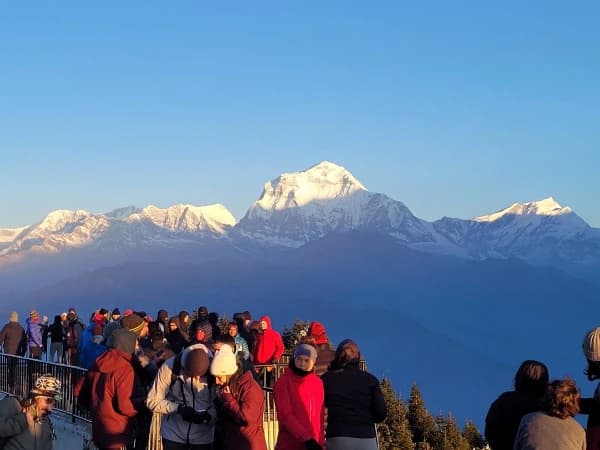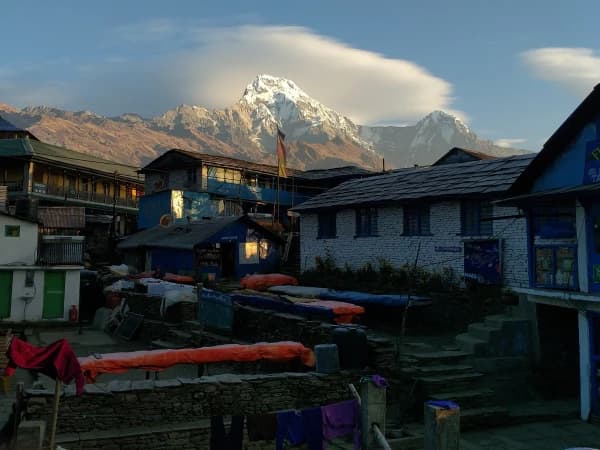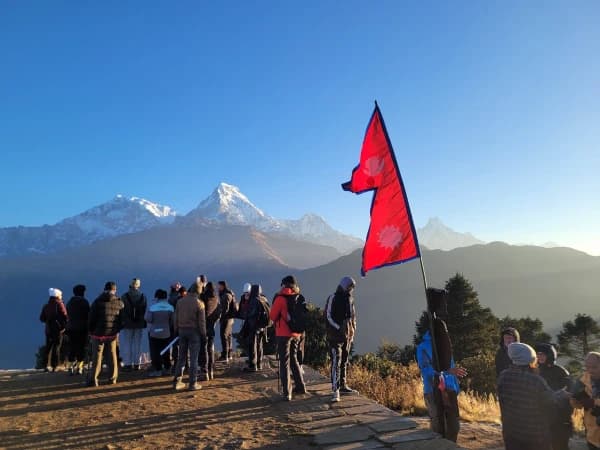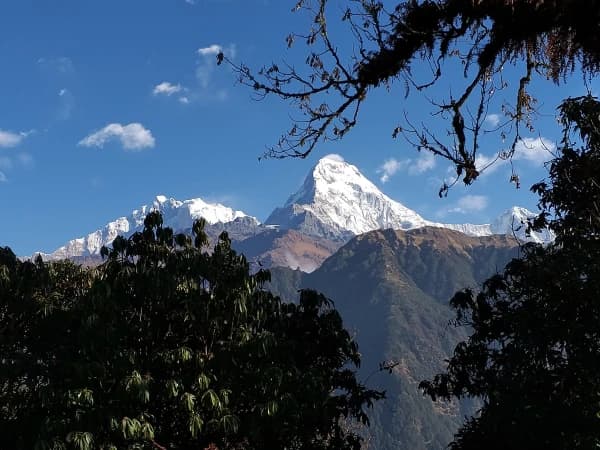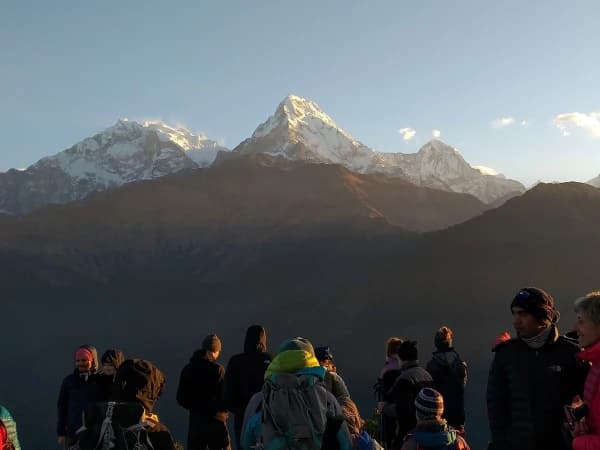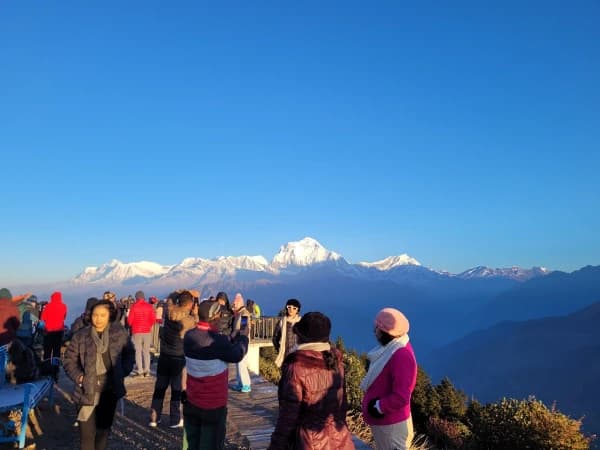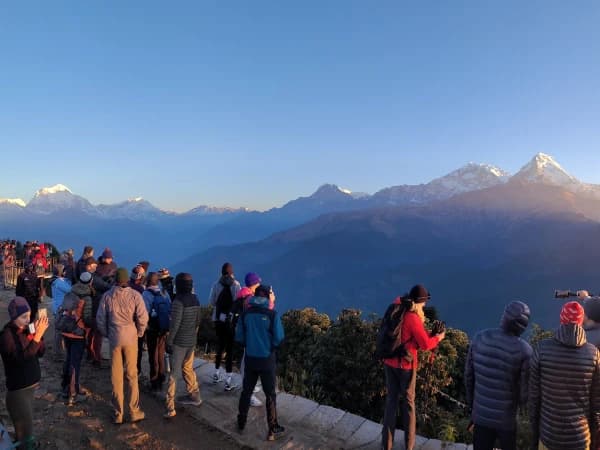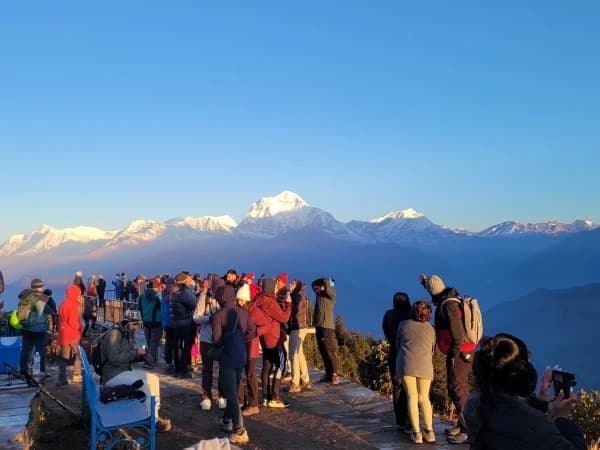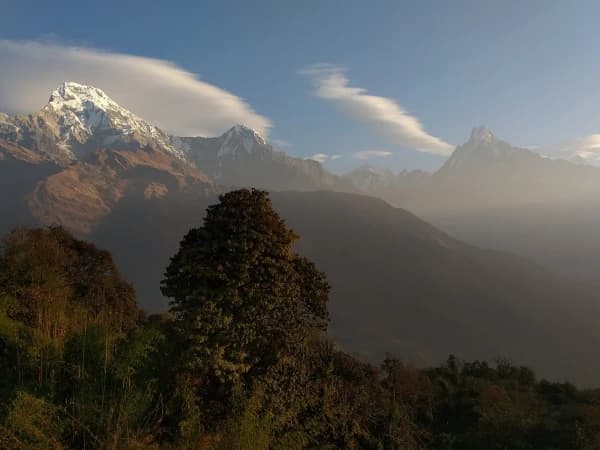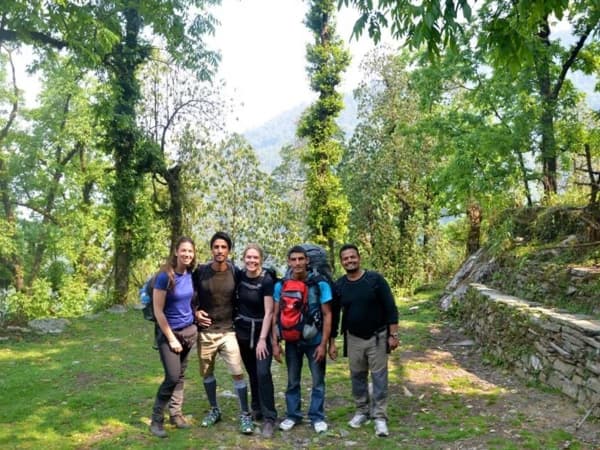Ghorepani Poon Hill Trek is perfect for those who want to get a short trek in with the most beautiful panoramic views of the Himalayas. Boasting captivating views of both the Annapurna and Dhaulagiri mountain ranges with a blissful sunrise, this trek is one you don’t want to miss.
Largely a beginner-friendly trek, we would still recommend you get some fitness days before the trip due to the number of stairs on the trail. However, with its popularity, accessibility from Pokhara, well-labeled trails, and numerous stops along quaint villages, it is one of the most family-friendly treks in Nepal and is perfect for novices. A little note on its nomenclature: ‘Ghore’ means horse and ‘pani’ means water, so it is likely that ancient traders stopped and settled here to quench the thirst of their horses.
Highlights:
- A short trek that gives you a panoramic view of the Himalayas, including the iconic Annapurna and Dhaulagiri range
- A trail that takes you along quaint villages and forest landscapes, and hilly ridges
- Comfortable lodges with warm Nepali hospitality and healthy meals along the trail
- A stop at Ghandruk allows you to visit a museum about the indigenous Gurung people of the region.
- An opportunity to explore Pokhara, a picturesque city with one of the largest lakes in Nepal, an international mountain museum, and adventure sports
- The capital city, Kathmandu, has a host of UNESCO World Heritage Sites that date back centuries, with a rich history of trade, art, and culture
What can I expect from the Ghorepani Poon Hill trek?
The Ghorepani Poon Hill offers a glimpse into the diverse terrain whether it be forests, ascending hills, or the mountain ranges that peek out from hills. Different terrains also mean different climates and communities, which means this trek offers you an excellent opportunity to know more about the people of Nepal. It is a well-marked and popular trail, so there is no shortage of comfortable lodges with plenty of rest points (and viewpoints) along the way.
As you make your way to quaint villages like Ulleri, Tadapani, and Ghandruk, the views of the mountains never leave you, offering a sense of tranquility and wonder. The villages of Ghorepani and Ghandruk also offer you a comfortable stay and opportunities to learn more about especially Gurung, Magar, and other communities living in the foothills of the Himalayas. At the final vista, Poon Hill, the sun rises over more than 20 different mountain peaks from the world renowned Himalayan range. A humbling and rejuvenating view, many leave here with a sense of renewed spirits.
Five days of trekking also means that this is a shorter trail, especially for those who may not have a full two weeks on their schedule to do a trek. It is also an accessible one and falls within moderate difficulty, which means that as long as you are fairly physically active, you will not have any issues on this trek. This trail can also be relatively more comfortable and luxurious than other treks in Nepal due to its popularity and ease of access. It is also a great starting trek for those who want to know more about the Himalayas and trekking in Nepal.
Major Attractions of the Ghorepani poon hill Trek
You begin your journey in Kathmandu, which hosts a plethora of cultural and historic landmarks and festivals. From the iconic Kathmandu Durbar Square, which dates back to the 4th century, to the charming Boudha Stupa (also dating back to the 4th century), you will never have a dull day in the capital city. From here, we leave for Pokhara, the tourist capital of Nepal.
The trek will lead you to charming villages such as Ghandruk, where you will have ample opportunity to explore the local museum and observe the daily lifestyle of local residents. Ghandruk is renowned for Gurung traditional houses, authentic cuisine, vibrant culture, warm hospitality, and stunning natural vistas, all of which captivate the hearts of tourists visiting in Ghorepani poon hill trek.
Who is the Ghorepani Poon Hill trek suitable for?
The Ghorepani Poon Hill trek has been classified as an easy to moderate trek and is often recommended for families as well. While you do not need to be at peak fitness for this trek, it is best that you do some training before, as it has many stairs along the trail. If you can walk for 4 to 6 hours and can handle some steepness and stairs, then you should have absolutely no difficulty in this trek.
We welcomes trekkers of any age and ability and whether they are coming in for a solo trek or as a group. In all cases, you will be accompanied by a porter and a guide for a smoother and a more immersive experience. It is a perfect short trek for families, for those wanting to do a quick foray into trekking in Nepal, and for those who want to learn about the communities living in the foothills of the Himalayas.
Preparation before the Ghorepani Poon Hill Trek
If you are ready and committed to this trek but are not in top shape for one, there is no need to fret. All you need to do is build your strength and stamina in one or two months. Simple strength training and going on regular walks around the neighborhood (and if you are extra ambitious, you can always load your backpack with heavy books) will do wonders for your stamina and endurance. Additionally, you can run, swim, hike, and cycle to build up your stamina. As long as you are keeping yourself physically active and strong, you will be able to do this trek!
Ghorepani Poon Hill Trek Difficulty
The Ghorepani Poon Hill trek is an easy to moderate trek with undulating hills and a maximum altitude of 3210 meters with a total distance of around 50 kilometers to cover across the trail. Since it features a large number of stairs, it is best that you get some fitness training in before the trail; however, it should not pose an issue as long as you take things slow and trek at your own pace. Anyone can join this trek, and prior experience is not necessary. You will be walking an average of 5 to 7 hours per day, and at around 2500 to 3000 meters in altitude.
In terms of service along the trail, there are numerous lodges with comfortable bedding, fresh and hot food as per your order with additional services Wi-Fi, charging stations, and hot showers available with a small charge.
- Note, often hot showers are heated by gas, so we insist you are careful of any gas leakages and do not take too long of a shower to avoid any incidents.
What to pack for the Ghorepani Poon Hill trek?
In order to avoid last-minute packing, we have a list of things you will need for the trek. However, if you miss anything from the list below, Kathmandu and Pokhara, two major cities in Nepal, we will visit, will have all your trekking essentials for you to purchase.
Clothes: Underwear, thermal layer, trekking shirt and pants, fleece jacket, down jacket, windbreaker/waterproof jacket and pants, cotton socks, woolen socks, neck warmer or scarf, gloves, sunhat, beanie or winter hat, ear muffs, trekking boots, flip flops/sandals, microfiber towel (or any towel that dries fast)
Trekking Gear: Trekking poles, daypack, duffel bag, sunglasses, reusable water bottle or hydration packs (or both!), map, guidebook, headtorch, travelers' knife, waterproof bag for important documents (in case of rain or snow)
Toiletries and First Aid: Sunscreen, lip balm, moisturizer, wet wipes, toilet paper, soap and shampoo bar, comb, toothpaste and brush, deodorant, antiseptic cream, band-aid, pain relief spray, water purification tablets, general medicine (for indigestion, pain relief etc), oral rehydration salts, electrolytes, insect repellent, allergy medicine or inhaler (if required), knee brace or compressor (if required), hand sanitizer
Miscellaneous: Adapter, charger, power bank, camera (if bringing), spare batteries for your camera, snacks, journal/pen, travel insurance document, passport, visa, passport-sized photos, cash
Trip Nutshell
- Trek Duration: 5 days from Pokhara to Pokhara
- The trek starts from Nayapul
- Trek ending point is Birethati
- Elevation: Ghorepani poon hill trek 3,210 meters (10,531 feet) above sea level
- Located: Annapurna Conservation Area, northwest of Pokhara, Nepal
- Trek distance 54 kilometers (34 miles)
- Popular route Ghorepani Poon Hill Trek
- Offers panoramic vistas of the Annapurna, Dhaulagiri Himalayan range
- Trek passes through terraced fields and lush forests.
- Socialize: Local Gurung and Magar communities
- Opportunities: Experience local culture, architecture, and hospitality
- Ideal Seasons: Spring and Autumn are the best times to visit
- Weather: Generally stable weather and clear skies during these periods
- Accommodation: Teahouses and lodges along the trekking route
- Food: Local cuisine and Western varieties’ food
- Safety and Challenges: Less risk of altitude sickness
- Permit: TIMS Card and ACAP Permit
- Transportation: By road or a short flight from Kathmandu to Pokhara
- Biodiversity: Various species of flora and fauna (rhododendrons, orchids…), and rare animals
- Trek category: Ghorepani poon hill trek is Easy to moderate
Ready for to experience of the Himalayan lifestyle
Having gained insight into trekking to Ghorepani Poonhill, we invite you to embark on an extraordinary journey to the Himalayas with us. Iconic Himalaya has been a prominent work in the tourism and trekking industry for over 20 years. We have assisted numerous trekkers in designing exciting, fulfilling, and often transformative trekking experiences in the Annapurna region. You can rely on us to ensure that your trip becomes an unforgettable experience.
